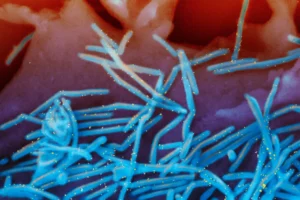Syphilis Cases Spike in Wyoming in Past Four Years, Data Reveals
Health official says ‘easy access to sexual networking’ could play a role in upward trend
- Published In: Other News & Features
- Last Updated: Oct 13, 2023

In the U.S., syphilis cases increased by about 32% from 2020 to 2021, data shows. (Courtesy graphic from the Centers for Disease Control and Prevention)
By Shen Wu Tan
Special to the Wyoming Truth
Health officials are warning the public about a growing epidemic of sexually transmitted infections, and syphilis cases in Wyoming are no exception to that trend as recently published health data illustrates.
Incidents of the sexually transmitted infection (STI) have surged by nearly 54% from 2018 (43 cases) to 2022 (66 cases), according to the Wyoming Department of Health (WDH).
“There is not a simple answer or just one cause we can name,” Kim Deti, spokesperson for the health department, said about the uptick in syphilis cases. “The pandemic may have had a temporary effect on testing and treatment access.”
Other potential factors that could explain the increase include an upward trend in STIs nationwide, various testing methods for different diseases and discomfort when discussing sexual health, especially in rural communities, Deti added.
Nationally, syphilis has been on the rise since 2017. That year, the U.S. recorded 101,590 cases, and in 2021, 176,713 incidents were reported, figures from the Centers for Disease Control and Prevention (CDC) show. Data reveals that gonorrhea cases also have increased from 555,608 in 2017 to 710,151 in 2021.
Lindy Gray, a family nurse practitioner at Cheyenne Laramie County Public Health, attributed the rise in syphilis cases to a range of factors.

“… Generally, there seems to be a lack of investment in public health,” she told the Wyoming Truth. “There is still a stigma surrounding sexual health and discussing this, along with a general lack of awareness and education about syphilis and STIs.”
Gray added many health care providers don’t address sex or sexual health with their patients during their visits and that relationships are not always monogamous.
“Online dating is on the rise, which creates easy access to sexual networking, and it opens the door to riskier sexual behaviors,” Gray said. “Drug use is still a factor, and the more drug use we see, the more high-risk sexual behaviors occur. When assessing patients, we find condom use, or barrier method use in general, is not a common practice, thus more STIs are occurring.”
STI trends
Syphilis is an STI spread by direct contact with a syphilis sore during vaginal, anal or oral sex, according to the CDC.
Syphilis can occur in four stages, beginning when a sore develops where it enters the body. In the second stage, a person might develop rashes and sores. During the latent stage, there are no visible signs or symptoms, but those who reach the last stage, tertiary syphilis, could experience adverse effects to different organ systems. The majority of people with untreated syphilis do not reach this stage.
But if left untreated, syphilis could damage the nervous system, brain and heart years later, Gray said. It can impact vision and hearing, as well as lead to dementia in severe cases. A pregnant woman with syphilis could pass it on to a fetus in utero, known as congenital syphilis, and experience a higher risk for miscarriages, premature births or stillbirths, death shortly after birth, meningitis and deformed bone development. The baby could suffer from brain issues, blindness and deafness.
Long-term, serious health concerns from syphilis can be prevented since the STI is curable.
“This is why we educate our community on why testing for STIs is important,” Rachael Wheeler, public health response coordinator for Teton County Public Health Department, told the Wyoming Truth. “Most STIs, when detected early, are completely curable with no long-term health effects.”
Although syphilis cases have climbed, rates of other STIs are on the decline, according to state health data. Wyoming saw a marked decrease in gonorrhea and chlamydia cases over the past three years—77.9 gonorrhea cases per 100,000 residents in 2019 versus 53.3 cases per 100,000 last year. There were 380.8 chlamydia cases per 100,000 residents in 2019 compared to 308 cases per 100,000 in 2022.
In April, the CDC reported syphilis, chlamydia and gonorrhea all increased between 2020 and 2021 with over 2.5 million recorded cases nationally. Rates for gonorrhea and chlamydia each climbed by about 4%, while syphilis cases surged nearly 32%. The 32% rise in congenital syphilis led to 220 stillbirths and infant deaths.
The Teton County Public Health Department recommends annual testing for STIs or more frequent testing based on a person’s exposure potential, Wheeler said. The department staff host quarterly Saturday testing events, and the state health department offers at-home testing for STIs as well.













